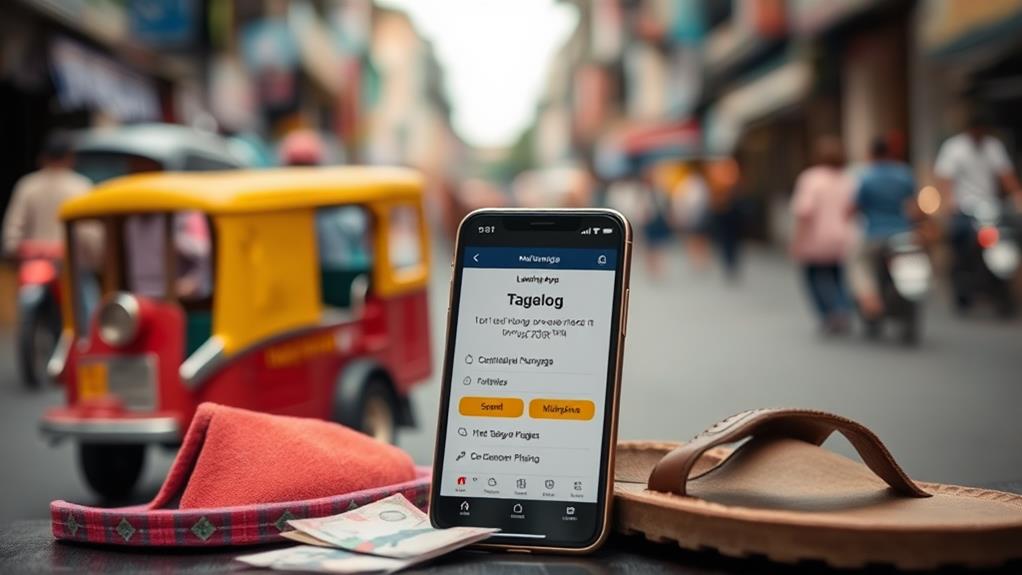Mastering Basic Tagalog Phrases for Travelers
When traveling to the Philippines, learning a few simple Tagalog phrases is essential for a smooth and respectful journey. "Salamat" means "Thank you", and adding "po" to the end of sentences shows respect. For example, "Salamat po" means "Thank you very much."
To navigate, ask "Nasaan ang [place]?", which means "Where is [place]?" For instance, "Nasaan ang hotel?" means "Where is the hotel?"
To inquire about prices, ask "Magkano po ito?", which means "How much is this?"
In case of an emergency, shout "Tulong!", which means "Help!" or say "Kailangan ng doktor", which means "Need a doctor."
Basic Tagalog Phrases

Making an Effort to Speak Tagalog Goes a Long Way
When interacting with locals, speaking their language shows respect for their culture and can greatly enhance your interactions.
Start with essential phrases like "Salamat" (Thank you) and "Kamusta?" (How are you?). Adding the word "po" to your sentences, like "Salamat po," adds a layer of politeness, especially when addressing elders or unfamiliar individuals.
Navigating with Confidence
When navigating, use phrases like "Nasaan ang [place]?" (Where is [place]?) and "Magkano po ito?" (How much is this?) to ask for directions and shop with confidence.
Handling Emergencies
In case of emergencies, memorize "Tulong!" (Help!) and "Kailangan ng doktor" (Need a doctor) to get help quickly.
Foodie Delights
If you're interested in trying Filipino food, ask "Anong masarap?" (What's delicious?) to get recommendations from locals.
Mastering Basic Tagalog Phrases
Mastering these basic Tagalog phrases will help you connect with the locals and make your trip more enjoyable.
Polite Expressions and Courtesies
Respectful Communication in the Philippines
When interacting with locals in the Philippines, using polite expressions and courtesies is essential to show respect for the culture. Adding "po" to the end of sentences is a crucial way to demonstrate respect, especially when speaking to elders or strangers. For example, saying "Salamat po" (Thank you) instead of just "Salamat" shows deference and appreciation.
Basic Polite Expressions
Pakiusap (Please) and Pasensya na (Have patience on me) are fundamental phrases to use in polite requests and apologies.
When expressing gratitude, saying Maraming salamat (Thank you very much) acknowledges someone's kindness in a respectful manner.
Greeting someone with Magandang araw po (Good day) or Kumusta po? (How are you?) sets a polite tone for the conversation.
Responding to Thank You
In the Philippines, responding to "thank you" with Walang anuman (You're welcome) reinforces the culture of hospitality and respect.
Asking for Directions

When navigating the Philippines without a guide, knowing the right phrases to ask for directions is crucial.
To ask for directions, "Nasaan ang [place]?" directly translates to "Where is [place]?", allowing you to inquire about the location of a specific destination. For instance, if you're looking for a museum, you'd ask "Nasaan ang museo?" (Where is the museum?).
If you need to know how to get to a particular place, "Paano pumunta sa [place]?" is the phrase to use, which means "How to get to [place]?" For example, if you want to get to the mall, you'd ask "Paano pumunta sa mall?" (How to get to the mall?).
Understanding directional instructions is also vital. "Kaliwa" means "left" and "Kanan" means "right", so if someone tells you to turn "Kaliwa", you know to turn left.
If you're unsure about the distance to your destination, "Malayo ba?" comes in handy, which means "Is it far?" This helps you gauge the distance and plan your journey accordingly.
If you're lost, saying "Nawawala ako" lets locals know you need help with directions.
Additionally, responding with "oo" (yes) or "wala" (no) to their instructions will help you navigate more efficiently.
Food and Shopping Essentials
When shopping or dining in the Philippines, knowing key phrases is crucial to enhance your experience.
To inquire about prices, say "Magkano po ito?". If you're interested in purchasing something, let the vendor know with "Bibili ako".
When dining, ask "Ano ang espesyalidad?" to discover local dishes and culinary highlights.
After a meal, express your gratitude with "Salamat sa pagkain". If you're looking to negotiate prices, try asking "May diskwento ba?".
Mastering these simple phrases will help you navigate food and shopping experiences like a pro, and show respect for the local culture.
Emergency and Help Phrases

In emergency situations, every second counts, and knowing the right phrases can be a lifesaver.
Tulong! (Help!) is a critical phrase to remember, especially in emergencies, as it quickly gets assistance from locals.
When seeking medical help, say Kailangan ng doktor (Need a doctor) if you're feeling unwell or injured.
If you need immediate medical attention, ask Nasaan ang ospital? (Where is the hospital?) to get directed to the nearest hospital.
In case of a fire emergency, shout May sunog! (There is a fire!) to warn others and seek immediate help.
If you're lost, inform locals by saying Nawawala ako (I am lost) to get help finding your way.
Cultural Insights and Traditions
The Philippines is a culturally diverse country with over 7,000 islands, each with its own distinct traditions, languages, and customs. This diversity is reflected in the strong emphasis on family, where respect for elders and close familial ties are deeply ingrained in social interactions and community gatherings.
Fiestas are an integral part of Filipino culture, celebrating historical events, religious beliefs, and local heritage. These vibrant festivals showcase the country's cultural insights and demonstrate the community's warm hospitality. For example, the Sinulog Festival in Cebu celebrates the Santo Niño, a symbol of Filipino Catholicism, while the MassKara Festival in Bacolod honors the city's history and culture.
Bayanihan, or communal unity, is a core value in Filipino culture. Locals often come together to help one another, demonstrating strong communal bonds. This spirit of cooperation is evident in community projects, such as rebuilding homes after natural disasters.
When interacting with locals, using polite language is essential. The honorific "po" is used to show respect, especially towards elders and strangers. Using this phrase helps build connections and shows appreciation for the culture. For instance, saying "Salamat po" (thank you) or "Oo po" (yes) demonstrates respect and courtesy.
Tagalog is the national language, and understanding its nuances is key to appreciating Filipino culture. Learning Tagalog phrases, such as "Kumusta?" (how are you?) or "Magandang umaga" (good morning), helps to build relationships and shows interest in the culture.
Learning Tagalog on the Go

Learning Tagalog on the Go
When traveling to the Philippines, speaking Tagalog enhances your interactions with locals and makes your trip more enjoyable. To quickly learn simple Tagalog phrases, use the right tools and mindset.
Download Language Learning Apps
Apps like Ling offer practical lessons focused on phrases useful for immediate use during travel. These apps provide a convenient way to learn Tagalog anywhere, anytime.
Practice in Everyday Situations
Use Tagalog phrases in your daily interactions, such as "Gusto ko ng [food/drink]" (I want [food/drink]) when ordering food or "Nasaan ang [place]?" (Where is [place]?) when asking for directions. This helps you apply your learning in real-life situations.
Take Advantage of Interactive Resources
Interactive quizzes and mini-games available on language learning platforms make the learning process more enjoyable and effective. These resources help you stay engaged and motivated to learn Tagalog.
Consistency is Key
Practice using Tagalog consistently, even if it's just for a few minutes a day, to improve your fluency and understanding of Filipino culture. Regular practice helps you retain information and build confidence in speaking Tagalog.
Engaging With Locals and Traditions
Speaking Tagalog Fosters Authentic Interactions
When navigating the Philippines, speaking Tagalog is essential for unlocking authentic interactions with locals. Using simple phrases like "Kamusta?" (How are you?) fosters friendly interactions and a sense of connection. Adding "po" to phrases, such as "Salamat po" (Thank you, respectfully), demonstrates politeness and respect, which is highly valued in Filipino culture. Locals appreciate tourists who make an effort to speak Tagalog, often responding positively and encouraging further conversation.
Understanding Local Expressions and Traditions
Knowing common expressions like "Ingat po kayo!" (Please take care!) reflects the Filipino emphasis on community and caring for one another.
Expressing appreciation for the country's beauty with phrases like "Ang gaganda ng mga tanawin dito!" (The views here are beautiful!) shows respect for the local culture.
Participating in local traditions, such as greeting with "Mano po" to elders, helps you immerse yourself in Filipino culture and strengthens social bonds.
By engaging with locals and traditions, speaking Tagalog opens doors to meaningful connections and unforgettable experiences.
Are Essential Tagalog Phrases for Beginners Useful for Tourists?
Learning essential tagalog phrases for beginners is incredibly useful for tourists exploring the Philippines. These phrases help travelers connect with locals, navigate unfamiliar places, and show respect for Filipino culture. Simple words like “Salamat” (Thank you) or “Magkano?” (How much?) can make a trip smoother and more enjoyable.
Overcoming Language Barriers

Overcoming language barriers is crucial when navigating the Philippines, as it can greatly impact your interactions with locals. Speaking Tagalog can be a powerful tool to overcome these barriers.
Combining gestures and visual aids with basic Tagalog phrases is essential to enhance understanding and clarify meaning when words fail. For instance, when asking for directions, using hand gestures to demonstrate the direction you want to go can help locals understand you better.
Practicing patience and speaking slowly is vital to help both you and locals understand each other, especially when language proficiency varies. This allows both parties to process the information and respond accordingly.
Using translation apps or tools can supplement your learning and provide immediate assistance in conversations when necessary. For example, Google Translate can help you translate words or phrases in real-time, ensuring you convey your message accurately.
Engaging in the local language, even if it's just a few phrases, can lead to more meaningful interactions with locals who appreciate the effort. By saying "salamat" (thank you) or "kumusta" (how are you), you show respect for their culture and language, which can lead to more positive interactions.
Frequently Asked Questions
What Is the Catchy Phrase of the Philippines?
The catchy phrase of the Philippines is "It's more fun in the Philippines!" This slogan captures the country's vibrant culture, rich history, and stunning beaches.
Philippine hospitality is a key aspect of this phrase, reflecting the nation's warm and welcoming nature. For example, Filipinos are known for their friendly smiles, willingness to help, and love for celebrations and gatherings.
When you visit the Philippines, you'll experience this hospitality firsthand.
Following basic travel etiquette, such as respecting local customs and traditions, will enhance your encounter with this incredible destination. By doing so, you'll be able to appreciate the country's beauty and culture even more.
What Is the Easiest Language to Learn if You Speak Tagalog?
Tagalog speakers can learn Spanish quickly due to the many borrowed words and phrases between the two languages. For instance, the Tagalog word "kumusta" (how are you?) is derived from the Spanish phrase "¿cómo estás?".
English is another language that Tagalog speakers can pick up easily, thanks to its widespread use in education and media in the Philippines. This exposure to English language resources and media makes it more relatable and accessible to Tagalog speakers.
Malay, Indonesian, and Vietnamese may also be easy for Tagalog speakers to learn due to language similarities and cultural nuances. For example, all four languages belong to the Austronesian language family and share similar grammatical structures.
Additionally, the cultural contexts of these languages are also similar, making it easier for Tagalog speakers to understand and relate to them.
With the right resources and motivation, Tagalog speakers can learn these languages quickly and effectively.
What's a Common Filipino Saying?
Filipino sayings hold significant cultural value, reflecting the nation's values and traditions. These phrases are often used in everyday life, conveying important messages and principles.
"Basta't sama-sama, kaya natin" (as long as we're together, we can do it) is a common phrase that emphasizes the importance of unity and teamwork.
Another example is "Kapag may tiyaga, may nilaga" (if there's perseverance, there's success), which highlights the value of hard work and determination.
While regional variations exist, these sayings are widely recognized and understood across the Philippines.
What Do Filipinos Say to Each Other?
When interacting with Filipinos, you'll notice they use specific greetings and expressions in their daily conversations.
They greet each other with "Kamusta?", which means "How are you?" in English. In response to this greeting, they express gratitude by saying "Salamat", which means "Thank you."
When someone thanks them, they respond with "Walang anuman", which translates to "You're welcome" or "It was nothing."
In everyday conversations, you'll often hear "Sige", which means "Okay" or "Go ahead." Filipinos also add "po" to sentences as a sign of respect, similar to saying "sir" or "ma'am" in English.
To ask someone's origin, they ask "Taga saan ka?", which means "Where are you from?"
Understanding these cultural expressions and greetings will help you connect with the locals and enhance your experience in the Philippines.